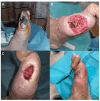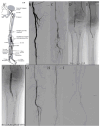Atherectomy in the Treatment of Peripheral Arterial Disease-A Case Series to Demonstrate Preferable Indications with Good Outcomes and a Literature Review
- PMID: 40094864
- PMCID: PMC11900047
- DOI: 10.3390/jcm14051437
Atherectomy in the Treatment of Peripheral Arterial Disease-A Case Series to Demonstrate Preferable Indications with Good Outcomes and a Literature Review
Abstract
Background: Endovascular therapy for lower-limb arterial disease is widely performed today. A vast array of sheaths, catheters, wires, balloon types, stents, and tools such as atherectomy, thrombectomy, and lithotripsy devices are now available to achieve the best outcomes in terms of vessel patency and ultimately limb salvage. The use of atherectomy devices, however, has raised some controversies in terms of outcome efficacy, cost effectiveness, and safety profile in various series and studies. Objectively, the types and disease pattern in these studies are also greatly heterogeneous. Methods: Here, we reported three cases which exemplify how these atherectomy devices have served as a valuable tool, especially for patients with complex and heavily calcified lesions. Results: The three cases highlighted scenarios where atherectomy displayed good outcomes, each involving the use of atherectomy devices to treat highly calcified vessels. Conclusions: Despite the concerns with atherectomy devices, we believe that with proper selection, patients will benefit most from their ability to achieve the best outcomes of both vessel patency and limb salvage.
Keywords: angioplasty; atherectomy; endovascular; peripheral arterial disease.
Conflict of interest statement
The authors declare no conflicts of interest.
Figures





References
-
- Usman M.S., Khan M.S., Butler J. Chronic Kidney Disease and Type 2 Diabetes. American Diabetes Association; Arlington, VA, USA: 2021. [(accessed on 12 August 2024)]. The Interplay Between Diabetes, Cardiovascular Disease and Kidney Disease. Available online: https://www.ncbi.nlm.nih.gov/books/NBK571718. - PubMed
-
- Nakabayashi K., Ando H., Kaneko N., Shiozaki M., Sunaga D., Matsui A., Tanaka K., Shimizu M. A novel lesion crossing technique: Balloon deployment using FORcible Manner (BADFORM) technique. Catheter. Cardiovasc. Interv. Off. J. Soc. Card. Angiogr. Interv. 2017;90:1161–1165. doi: 10.1002/ccd.27119. - DOI - PubMed
Publication types
LinkOut - more resources
Full Text Sources

